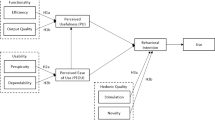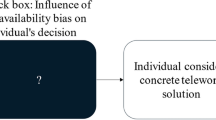Abstract
It is often observed in China that the user acceptance of a new information technology starts satisfactorily well when it is strongly promoted or even enforced to be used, but declines sharply after the initial stage. Based on an extended model derived from the Technology Acceptance Model (TAM), this paper presents two studies in academic and governmental contexts respectively to analyze such phenomena from a post-adoption perspective. Results from structured equation model (SEM) analyses demonstrate the ability of the model to interpret the IT acceptance behavior of Chinese users both during and after the initial stage. It is then inferred that the initial rise of user acceptance is usually driven by mandatory instructions due to the managerial characteristics of long power distance in Chinese organizations, while the drop in the second period is caused by changes that occur in some of the recognition factors in the model, which may reflect the lack of fit between technology and work style. In the two specific cases studied in the paper, the lack of compatibility and facilitating conditions made the user acceptance decline after the initial period when the effects of training and mandatory instructions faded away.






Similar content being viewed by others
Notes
References
Agarwal, R., & Karahanna, E. (2000). Time flies when you’re having fun: cognitive absorption and beliefs about information technology usage. MIS Quarterly, 24, 665–694.
Agarwal, R., & Prasad, J. (1998). The antecedents and consequents of user perceptions in information technology adoption. Decision Support Systems, 22, 15–29.
Agarwal, R., Sambamurthy, V., & Stair, R. M. (2000). The evolving relationship between general and specific computer self-efficacy—an empirical assessment. Information Systems Research, 11, 418–430.
Ajzen, I., & Fishbein, M. (1980). Understanding attitudes and predicting social behavior. Englewood Cliffs: Prentice-Hall.
Benbasat, I., & Barki, H. (2007). Quo Vadis, TAM? Journal of AIS, 8, 211–218.
Bhattacherjee, A. (2001). Understanding information systems continuance: an expectation-confirmation model. MIS Quarterly, 25, 351–370.
Bhattacherjee, A., & Premkumar, G. (2004). Understanding changes in belief and attitude toward information technology usage: a theoretical model and longitudinal test. MIS Quarterly, 28, 229–254.
Chau, P. Y. K., & Hu, P. J. (2002). Examining a model of information technology acceptance by individual professionals: an exploratory study. Journal of Management Information Systems, 18, 191–229.
Chen, G., Wu, R., & Guo, X. (2007). Key issues in information systems management in China. Journal of Enterprise Information Management, 20, 198–208.
Chin, W. W. (1998). Issues and opinion on structural equation modeling. MIS Quarterly, 22, vii–xvi.
Compeau, D., Higgins, C. A., & Huff, S. L. (1999). Social cognitive theory and individual reactions to computing technology: a longitudinal study. MIS Quarterly, 23, 145–158.
Davis, F. D. (1989). Perceived usefulness, perceived ease of use, and user acceptance of information technology. MIS Quarterly, 13, 319–340.
Davis, F. D., Bagozzi, R. P., & Warshaw, P. R. (1989). User acceptance of computer technology: a comparison of two theoretical models. Management Science, 35, 982–1003.
Dennis, A. R., & Reinicke, B. A. (2004). BETA versus VHS and the acceptance of electronic brainstorming technology. MIS Quarterly, 28, 1–20.
Dishaw, M. T., & Strong, D. M. (1999). Extending the technology acceptance model with task-technology fit constructs. Information & Management, 36, 9–21.
Dwivedi, Y. K., Williams, M. D., & Venkatesh, V. (2008). A profile of adoption of information and communication technologies (ICT) research in the household context. Information Systems Frontier, 10, 385–390.
Fichman, R. G. (1992). Information technology diffusion: A review of empirical research. The Thirteenth International Conference on Information Systems. Dallas, Texas, United States.
Gallivan, M., & Srite, M. (2005). Information technology and culture: identifying fragmentary and holistic perspectives of culture. Information & Organization, 15, 295–338.
Goodhue, D. L., & Thompson, R. L. (1995). Task-technology fit and individual performance. MIS Quarterly, 19, 213–226.
Guo, X., & Chen, G. (2004). Patterns of the internet adoption in different Chinese companies. In C.-P. WEI (Ed.), Proceedings of the eight Asia-Pacific conference on information systems. Shanghai: Fudan University.
Guo, X., & Chen, G. (2005). Internet diffusion in Chinese companies. Communications of the ACM, 48, 54–58.
Hofstede, G. (2001). Culture’s consequences: Comparing values, behaviors, institutions, and organizations across nations (2nd ed.). Thousand Oaks: Sage.
Igbaria, M., Zinatelli, N., Cragg, P., & Cavaye, A. L. M. (1997). Personal computing acceptance factors in small firms: a structural equation model. MIS Quarterly, 21, 279–305.
Karahanna, E., Straub, D. W., & Chervany, N. L. (1999). Information technology adoption across time: a cross-sectional comparison of pre-adoption and post-adoption beliefs. MIS Quarterly, 23, 183–213.
Karahanna, E., Ahuja, M., Srite, M., & Galvin, J. (2002). Individual differences and relative advantage: the case of GSS. Decision Support Systems, 32, 327–341.
Katz, M. L., & Shapiro, C. (1986). Technology adoption in the presence of network externalities. Journal of Political Economy, 94, 822–841.
Kim, S. S., & Malhotra, N. K. (2005). A longitudinal model of continued IS use: an integrative view of four mechanisms underlying postadoption phenomena. Management Science, 51, 741–755.
Kunnathur, A. S., & Shi, Z. (2001). An investigation of the strategic information systems planning success in Chinese publicly traded firms. International Journal of Information Management, 21, 423–439.
Legris, P., Ingham, J., & Collerette, P. (2003). Why do people use information technology? A critical review of the technology acceptance model. Information & Management, 40, 191–204.
Lewis, W., Agarwal, R., & Sambamurthy, V. (2003). Sources of influence on beliefs about information technology use: an empirical study of knowledge workers. MIS Quarterly, 27, 657–678.
Lippert, S. K., & Forman, H. (2005). Utilization of information technology: examining cognitive and experiential factors of post-adoption behavior. IEEE Transactions on Engineering Management, 52, 363–381.
Martinsons, M. G. (2005). Transforming China. Communications of the ACM, 48, 44–48.
Mathieson, K. (1991). Predicting user intentions: comparing the technology acceptance model with the theory of planned behavior. Information Systems Research, 2, 173–191.
Moore, G. C., & Benbasat, I. (1991). Development of an instrument to measure the perceptions of adopting an information technology innovation. Information Systems Research, 2, 192–222.
Plouffe, C. R., Hulland, J. S., & Vandenbosch, M. (2001). Richness versus parsimony in modeling technology adoption decisions—understanding merchant adoption of a smart card-based payment system. Information Systems Research, 12, 208–222.
Reimers, K., Guo, X., & Chen, G. (2009). Do IT-managers learn how to control spending on new information technology? A study of IT-budget growth in Chinese companies. Database for Advances in Information Systems, 1, 20–37.
Rogers, E. M. (1995). Diffusion of inovations. New York: The Free.
Szajna, B. (1996). Empirical evaluation of the revised technology acceptance model. Management Science, 42, 85–92.
Taylor, S., & Todd, P. A. (1995). Assessing IT usage: the role of prior experience. MIS Quarterly, 19, 561–570.
Thatcher, J. B., & Perrewe, P. L. (2002). An empirical examination of individual traits as antecedents to computer anxiety and computer self-efficacy. MIS Quarterly, 26, 381–396.
Thompson, R. L., & Higgins, C. A. (1991). Personal computing: toward a conceptual model of utilization. MIS Quarterly, 15, 125–143.
Thong, J. Y., Hong, S. J., & Tam, K. Y. (2006). The effects of post-adoption beliefs on the expectation-confirmation model for information technology continuance. International Journal of Human-Computer Studies, 64, 799–810.
Venkatesh, A. (2000). Determinants of perceived ease of use: integrating control, intrinsic motivation, and emotion into the technology acceptance model. Information Systems Research, 11, 342–365.
Venkatesh, V., & Davis, F. D. (2000). A theoretical extension of the technology acceptance model: four longitudinal field studies. Management Science, 46, 186–204.
Venkatesh, V., & Morris, M. G. (2000). Why don’t men ever stop to ask for directions? Gender, social influence, and their role in technology acceptance and usage behavior. MIS Quarterly, 24, 115–239.
Venkatesh, V., & Ramesh, V. (2006). Web and wireless site usability: understanding differences and modeling use. MIS Quarterly, 30, 181–205.
Venkatesh, A., Morris, M. G., & Davis, G. B. (2003). User acceptance of information technology: toward a unified view. MIS Quarterly, 27, 425–478.
Venkatesh, V., Davis, F. D., & Morris, M. G. (2007). Dead or alive? The development, trajectory and future of technology adoption research. Journal of AIS, 8, 267–286.
Wang, C., Zhang, X., & Yu, S. (2006). China e-government development report (3rd ed.). Beijing: Social Sciences Academic Press.
Wixom, B. H., & Todd, P. A. (2005). A theoretical integration of user satisfaction and technology acceptance. Information Systems Research, 16, 85–102.
Yi, M. Y., & Hwang, Y. J. (2003). Predicting the use of web-based information systems: self-efficacy, enjoyment, learning goal orientation, and the technology acceptance model. International Journal of Human-Computer Studies, 59, 431–449.
Yiu, C. S., Grant, K., & Edgar, D. (2007). Factors affecting the adoption of internet banking in Hong Kong—implications for the banking sector. International Journal of Information Management, 27, 336–351.
Zhang, N., Guo, X., Chen, G., & Chau, P. Y. K. (2009). Impact of perceived fit on e-government user evaluation: a study with a Chinese cultural context. Journal of Global Information Management, 17, 49–69.
Zhu, K., & Kraemer, K. L. (2005). Post-adoption variations in usage and value of e-business by organizations: cross-country evidence from the retail industry. Information Systems Journal, 16, 61–84.
Zhu, J. J. H., & Wang, E. (2005). Diffusion, use, and effect of the internet in China. Communications of the ACM, 48, 49–53.
Acknowledgements
The work was partly supported by the National Natural Science Foundation of China (70972029/70890081/70621061/70831003), China Postdoctoral Science Foundation (20080440030/201003094), the Research Center for Contemporary Management, and the E-Government Lab of Tsinghua University. The authors would like to thank Professor Wayne Wei Huang from Ohio University, for his valuable comments on the draft of this paper.
Author information
Authors and Affiliations
Corresponding author
Rights and permissions
About this article
Cite this article
Zhang, N., Guo, X. & Chen, G. Why adoption and use behavior of IT/IS cannot last?—two studies in China. Inf Syst Front 13, 381–395 (2011). https://doi.org/10.1007/s10796-010-9288-3
Published:
Issue Date:
DOI: https://doi.org/10.1007/s10796-010-9288-3




